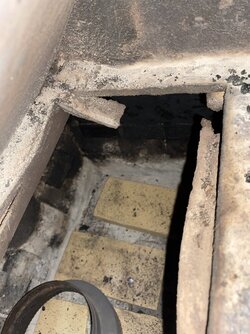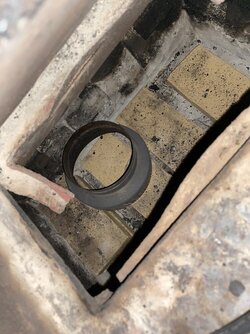BKVP
Minister of Fire
First fire of 2022-2023! Last match of 2022-2023!
Same here, well first fire, cat just started glowing.First fire of 2022-2023! Last match of 2022-2023!
For all this talk of mechanically-failed combustors, I have put about 70 cords of wood thru a pair of Ashford 30's, with 2/3 of that being on one stove and 1/3 on the other, and probably around 30 cords on just one ceramic combustor, without ever even a hint of cracking or distortion. This leads me to believe that anyone cracking a combustor is doing it through negligence or poor stove maintenance, and not thru regular and careful operation.
I'm not doing anything unusually prudent, but:
1. I always open bypass before going out to fetch fresh wood. This gives combustor a few minutes to cool, before I'm back to open the door and load.
2. I let the stove burn on high for 5 minutes after loading before closing the bypass, such that I'm not putting dead-cold exhaust thru a warm combustor.
3. I burn wood that is actually CSS'd 3 summers (or more).
Seems like people burning softwood are getting less hours out of their cats. From what I’ve read so far.
Nah, I think soft wood is easier than hardwoods, nonscientific but hard woods seem to need / generate more heat to burn and keep burning giving the cat high temp exposure, I find when I burn eastern white pine the stove sets up and cruises better then with oak which takes more heat before throttling back a bit on the t-statSeems like people burning softwood are getting less hours out of their cats. From what I’ve read so far.
Interesting debate, but I think I’d tend to believe Highbeam’s scenario. While hardwood may burn hotter, and thus expose the cat to higher exhaust temps, I believe the cat likely has a higher average temperature in his softwood usage scenario, due to the work it is doing. Aging is likely related to temperature*hours product in some way, so it would make sense that softwoods make it run hotter, if we accept that members running softwood are depleting their cats (or at least actually suffering from diminished performance) faster than those running hardwood.Nah, I think soft wood is easier than hardwoods, nonscientific but hard woods seem to need / generate more heat to burn and keep burning giving the cat high temp exposure, I find when I burn eastern white pine the stove sets up and cruises better then with oak which takes more heat before throttling back a bit on the t-stat
Our 1st world problems are amazing lolInteresting debate, but I think I’d tend to believe Highbeam’s scenario. While hardwood may burn hotter, and thus expose the cat to higher exhaust temps, I believe the cat likely has a higher average temperature in his softwood usage scenario, due to the work it is doing. Aging is likely related to temperature*hours product in some way, so it would make sense that softwoods make it run hotter, if we accept that members running softwood are depleting their cats (or at least actually suffering from diminished performance) faster than those running hardwood.


Done.@Fisherman-Travis Contact @BKVP those channels were designed to melt / warp / break off during periods of running the stove on high with the by-pass open, he'll get you setup with the proper measurements / steel to use to make the repair.
I've seen it too; somewhat lazy (but hot) flames between the flame screen and the cat surface when there are no primary flames in the firebox.I'm a long time wood burner, but I'm very new to catalytic wood stoves. I have a new Ashford 20.2, and I've noticed that sometimes when I'm burning it in black box mode, I'll get flames dancing on the combustor. Is this normal? I've been reading all the threads about how to properly burn this type of stove, so I'm pretty sure I'm doing it right. I'm burning 16-18% MC red oak, if that matters.
Completely normal. It's a Hendrix Experience with just the right amount of bourbon!I'm a long time wood burner, but I'm very new to catalytic wood stoves. I have a new Ashford 20.2, and I've noticed that sometimes when I'm burning it in black box mode, I'll get flames dancing on the combustor. Is this normal? I've been reading all the threads about how to properly burn this type of stove, so I'm pretty sure I'm doing it right. I'm burning 16-18% MC red oak, if that matters.
Do you have any trouble keeping the wood that dry? Late this summer I had some black spruce that had been seasoned two years and it was down there around 12%. After some rain this fall it climbed up in the 17% range. It is stored in a covered woodshed with slat sides so I'm assuming that humidity is all that made the difference. The different could be the wood but it was all processed at the same time, placed on pallets with the top covered for two years and then put in the woodshed late this summer . I'm now farther back in the shed where there is one year old white spruce and it's running 16-18%. It will be interesting to see what it is after it's been below zero for a while. My splits are very small so it's possible that it may not be effected so much by the humidity if the splits were bigger? Overall heat output and burn time doesn't seem to be much different on my Sirocco 20 between 12% and 18%. I am finding the white spruce has small chunks left after 12 hours as where the black spruce would be all coal but that again could be split size.Down to about 13% MC, drier is better. Period. My stove runs best at 14% MC, but I only ever finished 8 cords at 14% once. It was a lovely year. 13-15% is fine. 16-17% is pretty good.
Thank you for pointing out wood is like a sponge! It can absorb MC for the air! All the more reason to cross stack wood, get it stacked on pallets and allow air passages on all four sides. The Woodway held a Wood Shed Challenge a few years ago there in FNSB. I was one of the judges and I can tell you some very, very clever designs took a great deal into consideration when designing their wood sheds.Do you have any trouble keeping the wood that dry? Late this summer I had some black spruce that had been seasoned two years and it was down there around 12%. After some rain this fall it climbed up in the 17% range. It is stored in a covered woodshed with slat sides so I'm assuming that humidity is all that made the difference. The different could be the wood but it was all processed at the same time, placed on pallets with the top covered for two years and then put in the woodshed late this summer . I'm now farther back in the shed where there is one year old white spruce and it's running 16-18%. It will be interesting to see what it is after it's been below zero for a while. My splits are very small so it's possible that it may not be effected so much by the humidity if the splits were bigger? Overall heat output and burn time doesn't seem to be much different on my Sirocco 20 between 12% and 18%. I am finding the white spruce has small chunks left after 12 hours as where the black spruce would be all coal but that again could be split size.

